Visual Snow Initiative’s groundbreaking efforts, both past and present, have been pivotal in advancing global recognition and understanding of Visual Snow Syndrome. Through ongoing collaboration with researchers, supporters, and medical professionals, Visual Snow Initiative advances awareness, education, research, and treatment development while providing essential resources to improve the quality of life for those affected worldwide.


In 2024-2025, Sierra Domb, Dr. Peter Goadsby, and Dr. Owen White secured ICD Codes for both Visual Snow Syndrome (condition) and Visual Snow (symptom) from the World Health Organization, a significant and historic milestone that helped solidify medical and scientific legitimacy for Visual Snow Syndrome on a global scale
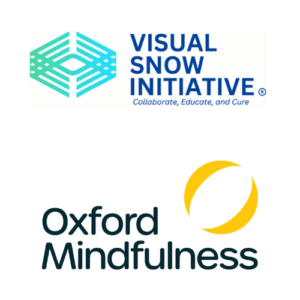
Based on published research and fMRI brain imaging by Dr. Sui Wong, which substantiated the efficacy of MBCT for alleviating Visual Snow Syndrome symptoms, Visual Snow Initiative partnered with Oxford Mindfulness Foundation (Oxford University) and created an app to make MBCT for Visual Snow Syndrome free and globally-accessible

Visual Snow Initiative launches VSI 4 Kids, the first resource designed specifically for children with Visual Snow Syndrome and parents, featuring kid-friendly language and a supportive community.
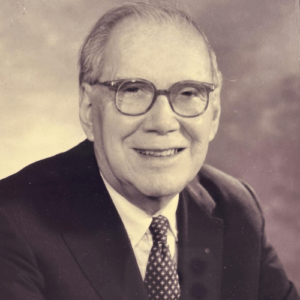
Visual Snow (static vision) was first discovered and reported in the Transactions of the American Ophthalmological Society by Frank D. Carroll.

Visual Snow Syndrome (VSS) was discovered to be its own medical condition separate from migraine/migraine aura (without infarction) by Dr. Grant Liu.
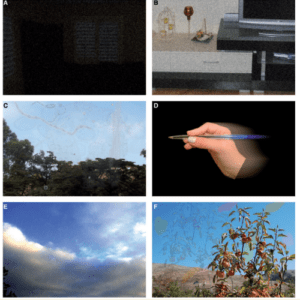
Dr. Peter Goadsby, Dr. Christoph Schankin, and Dr. Francesca Puledda discovered Visual Snow Syndrome (VSS) is a neurological disorder that affects vision, sensory experiences, brain network processing, and more; it is not an issue with the structural integrity of the eyes nor does it entail vascular issues like migraine.

Dr. Peter Goadsby, Dr. Christoph Schankin, and Dr. Francesca Puledda proposed separate clinical criteria for Visual Snow Syndrome and asserted it was a distinct medical entity.
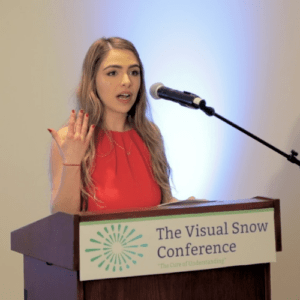
In 2018, Sierra Domb organized the first-ever Visual Snow Conference at University of California, San Francisco.
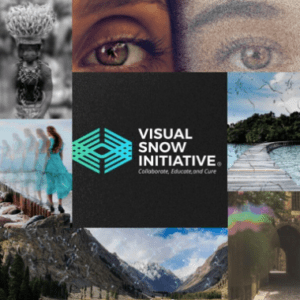
Sierra Domb founded the nonprofit organization, Visual Snow Initiative (VSI), and created the VSI Global Research Team consisting of researchers in 7 countries, including research pioneers Dr. Peter Goadsby, Dr. Christoph Schankin, Dr. Francesca Puledda, Dr. Owen White, Dr. Joanna Fielding, Dr. Victoria Pelak, Dr. Yasser Khan, and James Fulton.

Visual Snow Initiative (VSI) became the first organization to introduce and connect Visual Snow Syndrome experts globally, fostering collaboration among researchers who had not previously worked together. After researchers stated that progress was stagnant and funding was at risk, jeopardizing their ability to continue their studies, VSI reignited research efforts and maximized global collaboration to advance the understanding and study of the condition.
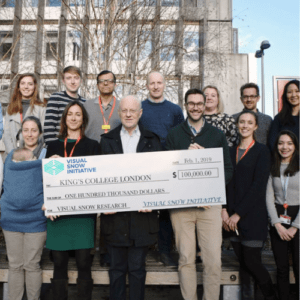
Visual Snow Initiative begins funding and working with researchers at academic institutions, including King’s College London, Monash University, and University of Colorado Denver.

Visual Snow Initiative establishes the Official Diagnostic Criteria for Visual Snow Syndrome.

Visual Snow Initiative established newfound awareness and media presence for Visual Snow Syndrome through continuous advocacy efforts, including sponsoring the Daytime Emmy Awards, creating public service announcements, awareness campaigns via social media, educational videos, and featured articles, news outlets, as well as partnerships with public figures, publications, and medical professionals to highlight the condition.
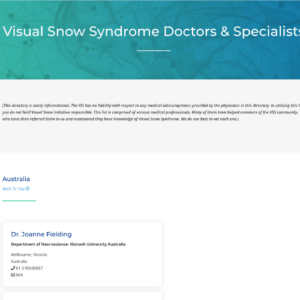
Visual Snow Initiative created the first Global Directory of Visual Snow Doctors and Specialists.
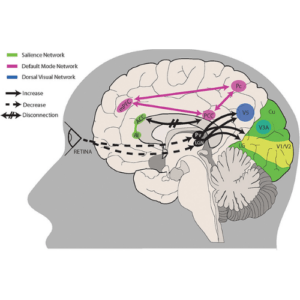
Visual Snow Initiative funded studies focusing on the pathophysiology and neurological underpinnings of Visual Snow Syndrome, including abnormal activity in the visual processing pathways of the brain and the condition’s relationship with migraine/migraine aura; Neuroimaging identified brain abnormalities that helped explain key features of the condition, including abnormal sensory processing, photophobia, and more.
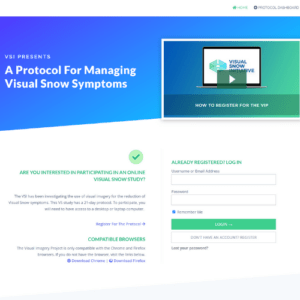
Visual Snow Initiative launched the Visual Imagery Project (VIP), a resource developed as part of an online study that examined whether continuous exposure to dynamic visual stimuli could impact or alleviate symptoms of Visual Snow Syndrome. The Visual Imagery Project provided a foundational framework for future research into the neural mechanisms of Visual Snow, focusing on the role of motion-selective neurons, simulations, and dynamic images in shaping perception. The VIP was built upon research trials and patient reports suggesting its potential effectiveness, featuring a 21-day protocol.

Visual Snow Initiative began working with neuroscientists at Massachusetts Institute of Technology, led by Dr. Edward “Ed” Boyden.

Research funded by Visual Snow Initiative discovered the structural and functional footprint of Visual Snow Syndrome, revealing that the condition is a network disorder that extends beyond the visual system into multiple different parts of the brain.

Researchers discovered that Visual Snow Syndrome is not as rare as previously thought, revealing that symptoms of the neurological condition affects an estimated 2-3% of the global population.
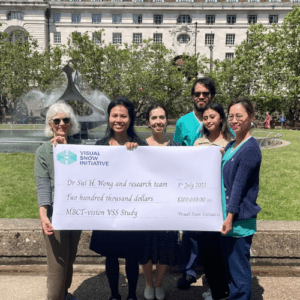
Alongside Guy’s and St Thomas’ NHS Foundation Trust, Visual Snow Initiative funded Dr. Sui Wong’s Mindfulness-Based Cognitive Therapy (MBCT) research into modulating and rewiring dysfunctional networks in the brain that are associated Visual Snow Syndrome.
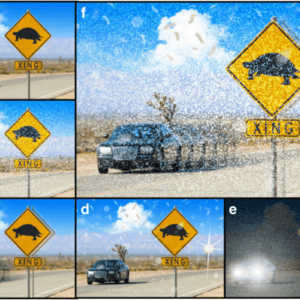
Supported by Visual Snow Initiative, the Monash University Research Team took groundbreaking first steps into defining a behavioral signature of Visual Snow Syndrome, identifying the brain areas involved, and processes affected.

Research funded by Visual Snow Initiative identifies first-ever demographic information, age prevalence, comorbidities, and further-refined symptomatology of Visual Snow Syndrome.
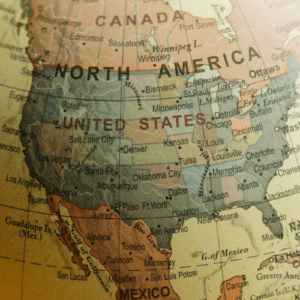
Visual Snow Initiative was contacted by people affected by Visual Snow Syndrome and medical professionals in 64 countries around the world.
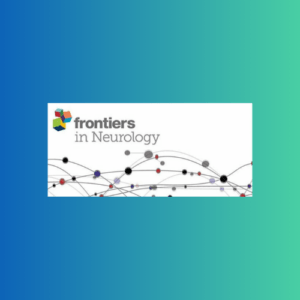
Visual Snow Initiative funded research that proved that Visual Snow Syndrome is NOT a psychiatric disorder nor simply a manifestation of anxiety and/or depression, a longtime untrue and harmful misconception; instead, the distressing nature of these symptoms coupled with the majority of the medical community’s historic marginalization of VSS patients can induce or worsen anxiety and/or depression; research also reaffirms that Visual Snow Syndrome has both visual and non-visual symptoms (Dr. Owen White, Dr. Joanne Fielding, Fielding-White Group research team).
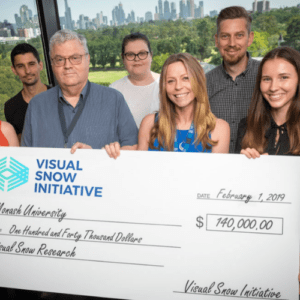
Visual Snow Initiative funded the first study to assess temporal changes in allocation of visuospatial attention in Visual Snow Syndrome, which provided a more refined saccadic behavioral profile of the condition that can be interrogated using sophisticated neuroimaging techniques; these findings evidenced that attention is impacted in VSS, manifesting in a distinct saccadic behavioral profile, and delayed onset of “Inhibition of Return”.

Visual Snow Initiative supported research vital to our understanding of the condition, which discovered patients with Visual Snow Syndrome present increased activation in a wide network of intrinsic brain areas that are key in the processing of complex sensory and cognitive states; Regional cerebral blood flow (rCBF) increases were independent of the presence of an external visual stimulus, suggesting that these abnormalities could be a causal factor of the neurological disorder.

Researchers Dr. Jenny Hepschke, Dr. Paul Martin, and Dr. Clare Fraser discovered that “short-wave sensitive (‘blue’) cone activation is an aggravating factor for symptoms, providing insights into how color modulation impacts VSS and the certain brain pathways that may be responsible for the condition’s pathogenesis.

Funded by the Visual Snow Initiative, the study “Visual Snow Syndrome as a Network Disorder: A Systematic Review“, officially confirmed that Visual Snow Syndrome is a network brain disorder. This conclusion was supported by the combination of the clinical presentation and widespread functional and structural alterations in both visual and extra-visual areas. These findings demonstrated that Visual Snow Syndrome involves brain regions responsible for more than just vision, explaining its impact on vision, hearing, sensory processing, cognition, and other functions.

Visual Snow Initiative was contacted by people affected by Visual Snow Syndrome and medical professionals in 71 countries around the world.

The advocacy work of Visual Snow Initiative resulted in the first-ever acknowledgement for Visual Snow Syndrome by renowned academic and medical institutions like Mayo Clinic and Johns Hopkins; they extended an invitation for Visual Snow Initiative to work with them, which. formed new collaborations.

“Development and persistence of patient-reported visual problems associated with serotonin reuptake inhibiting antidepressants” demonstrated that serotonin reuptake inhibiting antidepressants can produce a range of adverse effects on vision even after discontinuation of the drug, including Visual Snow Syndrome.

In an informative study funded by Visual Snow Initiative that significantly contributed to our understanding of Visual Snow Syndrome, researchers identified widespread changes in the microstructure of the gray matter in the brain, the most notable of these occurring in caudal regions including the occipital cortex.

Sierra Domb gave the first public speech and TEDx Talk about her journey with Visual Snow Syndrome (VSS), establishing Visual Snow Initiative, and facilitating progress in awareness, education, resources, and research for VSS.

Visual Snow Initiative hosted the VSI Virtual Summit and identified the first viable noninvasive methods and latest advancements to treat symptoms of Visual Snow Syndrome.

Visual Snow Initiative identified first noninvasive viable treatments proven to help Visual Snow Syndrome (VSS) symptoms identified in published clinical research (fMRI brain imaging, patient QOL reports, etc.); The newly-identified effective treatment modalities for VSS symptoms included Neuro-Optometric Rehabilitation Therapy (NORT) (research by Dr. Charles Shidlofsky, Dr. Terry Tsang, and Vanessa Mora) and Mindfulness-Based Cognitive Therapy (MBCT) (research by Dr. Sui Wong).

Visual Snow Initiative launched their new website designed by Mehrad Mazaheri with content from Sierra Domb and Vanessa Mora, offering first-ever accessible resources and new information about Visual Snow Syndrome for patients and medical professionals; new resources include the Visual Snow Patient Guide, Visual Snow Brochures (in multiple languages), a video library containing more than 500 educational videos produced by Visual Snow Initiative, and more.

Visual Snow Initiative-supported study discovered the first possible biomarkers of Visual Snow Syndrome: abnormal activity within the glutamate and serotonin networks in specific areas of the brain (Dr. Francesca Puledda and King’s College research team).

Visual Snow Initiative was contacted by people affected by Visual Snow Syndrome and medical professionals in 96 countries around the world.

Sierra Domb led an initiative and provided supporting testimony to secure Visual Snow Syndrome its own ICD code in the International Classification of Diseases (ICD-11) alongside Dr. Peter Goadsby and Dr. Owen White, who submitted the proposal.
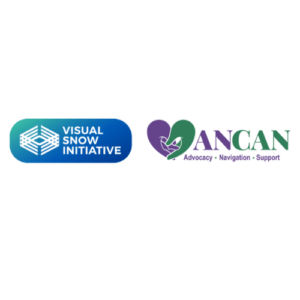
Visual Snow Initiative and AnCan Foundation launch first Video Support Group for Visual Snow Syndrome.

Sierra Domb, CEO & Founder, announced Visual Snow Initiative funded the first collaborative study to identify an effective medication for Visual Snow Syndrome using knowledge from recent research that identified specific brain pathways implicated in the condition (Dr. Peter Goadsby, Dr. Christoph Schankin, Dr. Francesca Puledda).

Since Sierra Domb founded Visual Snow Initiative in 2018, the number of research and publications for Visual Snow Syndrome has quadrupled.

In 2024-2025, Sierra Domb, alongside Dr. Peter Goadsby and Dr. Owen White, led a groundbreaking initiative through the Visual Snow Initiative (VSI) that achieved a historic milestone: securing official ICD codes from the World Health Organization for both Visual Snow Syndrome (the neurological condition) and Visual Snow (the symptom of seeing static 24/7). This achievement marked the first time Visual Snow Syndrome was globally recognized within the medical and scientific communities. This milestone is a monumental victory for patients who have been marginalized and dismissed since the condition was first reported in 1944. By obtaining official recognition, VSI has paved the way for better diagnosis, research, and treatment worldwide, delivering long-awaited validation to those living with this misunderstood condition.

In 2024-2025, Sierra Domb, Dr. Peter Goadsby, and Dr. Owen White secured ICD Codes for both Visual Snow Syndrome (condition) and Visual Snow (symptom) from the World Health Organization, a significant and historic milestone that helped solidify medical and scientific legitimacy for Visual Snow Syndrome on a global scale

Based on published research and fMRI brain imaging by Dr. Sui Wong, which substantiated the efficacy of MBCT for alleviating Visual Snow Syndrome symptoms, Visual Snow Initiative partnered with Oxford Mindfulness Foundation (Oxford University) and created an app to make MBCT for Visual Snow Syndrome free and globally-accessible

Visual Snow Initiative launches VSI 4 Kids, the first resource designed specifically for children with Visual Snow Syndrome and parents, featuring kid-friendly language and a supportive community.

Visual Snow (static vision) was first discovered and reported in the Transactions of the American Ophthalmological Society by Frank D. Carroll.

Visual Snow Syndrome (VSS) was discovered to be its own medical condition separate from migraine/migraine aura (without infarction) by Dr. Grant Liu.

Dr. Peter Goadsby, Dr. Christoph Schankin, and Dr. Francesca Puledda discovered Visual Snow Syndrome (VSS) is a neurological disorder that affects vision, sensory experiences, brain network processing, and more; it is not an issue with the structural integrity of the eyes nor does it entail vascular issues like migraine.

Dr. Peter Goadsby, Dr. Christoph Schankin, and Dr. Francesca Puledda proposed separate clinical criteria for Visual Snow Syndrome and asserted it was a distinct medical entity.

In 2018, Sierra Domb organized the first-ever Visual Snow Conference at University of California, San Francisco.

Sierra Domb founded the nonprofit organization, Visual Snow Initiative (VSI), and created the VSI Global Research Team consisting of researchers in 7 countries, including research pioneers Dr. Peter Goadsby, Dr. Christoph Schankin, Dr. Francesca Puledda, Dr. Owen White, Dr. Joanna Fielding, Dr. Victoria Pelak, Dr. Yasser Khan, and James Fulton.

Visual Snow Initiative (VSI) became the first organization to introduce and connect Visual Snow Syndrome experts globally, fostering collaboration among researchers who had not previously worked together. After researchers stated that progress was stagnant and funding was at risk, jeopardizing their ability to continue their studies, VSI reignited research efforts and maximized global collaboration to advance the understanding and study of the condition.

Visual Snow Initiative begins funding and working with researchers at academic institutions, including King’s College London, Monash University, and University of Colorado Denver.

Visual Snow Initiative establishes the Official Diagnostic Criteria for Visual Snow Syndrome.

Visual Snow Initiative established newfound awareness and media presence for Visual Snow Syndrome through continuous advocacy efforts, including sponsoring the Daytime Emmy Awards, creating public service announcements, awareness campaigns via social media, educational videos, and featured articles, news outlets, as well as partnerships with public figures, publications, and medical professionals to highlight the condition.

Visual Snow Initiative created the first Global Directory of Visual Snow Doctors and Specialists.

Visual Snow Initiative funded studies focusing on the pathophysiology and neurological underpinnings of Visual Snow Syndrome, including abnormal activity in the visual processing pathways of the brain and the condition’s relationship with migraine/migraine aura; Neuroimaging identified brain abnormalities that helped explain key features of the condition, including abnormal sensory processing, photophobia, and more.

Visual Snow Initiative launched the Visual Imagery Project (VIP), a resource developed as part of an online study that examined whether continuous exposure to dynamic visual stimuli could impact or alleviate symptoms of Visual Snow Syndrome. The Visual Imagery Project provided a foundational framework for future research into the neural mechanisms of Visual Snow, focusing on the role of motion-selective neurons, simulations, and dynamic images in shaping perception. The VIP was built upon research trials and patient reports suggesting its potential effectiveness, featuring a 21-day protocol.

Visual Snow Initiative began working with neuroscientists at Massachusetts Institute of Technology, led by Dr. Edward “Ed” Boyden.

Research funded by Visual Snow Initiative discovered the structural and functional footprint of Visual Snow Syndrome, revealing that the condition is a network disorder that extends beyond the visual system into multiple different parts of the brain.

Researchers discovered that Visual Snow Syndrome is not as rare as previously thought, revealing that symptoms of the neurological condition affects an estimated 2-3% of the global population.

Alongside Guy’s and St Thomas’ NHS Foundation Trust, Visual Snow Initiative funded Dr. Sui Wong’s Mindfulness-Based Cognitive Therapy (MBCT) research into modulating and rewiring dysfunctional networks in the brain that are associated Visual Snow Syndrome.

Supported by Visual Snow Initiative, the Monash University Research Team took groundbreaking first steps into defining a behavioral signature of Visual Snow Syndrome, identifying the brain areas involved, and processes affected.

Research funded by Visual Snow Initiative identifies first-ever demographic information, age prevalence, comorbidities, and further-refined symptomatology of Visual Snow Syndrome.

Visual Snow Initiative was contacted by people affected by Visual Snow Syndrome and medical professionals in 64 countries around the world.

Visual Snow Initiative funded research that proved that Visual Snow Syndrome is NOT a psychiatric disorder nor simply a manifestation of anxiety and/or depression, a longtime untrue and harmful misconception; instead, the distressing nature of these symptoms coupled with the majority of the medical community’s historic marginalization of VSS patients can induce or worsen anxiety and/or depression; research also reaffirms that Visual Snow Syndrome has both visual and non-visual symptoms (Dr. Owen White, Dr. Joanne Fielding, Fielding-White Group research team).

Visual Snow Initiative funded the first study to assess temporal changes in allocation of visuospatial attention in Visual Snow Syndrome, which provided a more refined saccadic behavioral profile of the condition that can be interrogated using sophisticated neuroimaging techniques; these findings evidenced that attention is impacted in VSS, manifesting in a distinct saccadic behavioral profile, and delayed onset of “Inhibition of Return”.

Visual Snow Initiative supported research vital to our understanding of the condition, which discovered patients with Visual Snow Syndrome present increased activation in a wide network of intrinsic brain areas that are key in the processing of complex sensory and cognitive states; Regional cerebral blood flow (rCBF) increases were independent of the presence of an external visual stimulus, suggesting that these abnormalities could be a causal factor of the neurological disorder.

Researchers Dr. Jenny Hepschke, Dr. Paul Martin, and Dr. Clare Fraser discovered that “short-wave sensitive (‘blue’) cone activation is an aggravating factor for symptoms, providing insights into how color modulation impacts VSS and the certain brain pathways that may be responsible for the condition’s pathogenesis.

Funded by the Visual Snow Initiative, the study “Visual Snow Syndrome as a Network Disorder: A Systematic Review“, officially confirmed that Visual Snow Syndrome is a network brain disorder. This conclusion was supported by the combination of the clinical presentation and widespread functional and structural alterations in both visual and extra-visual areas. These findings demonstrated that Visual Snow Syndrome involves brain regions responsible for more than just vision, explaining its impact on vision, hearing, sensory processing, cognition, and other functions.

Visual Snow Initiative was contacted by people affected by Visual Snow Syndrome and medical professionals in 71 countries around the world.

The advocacy work of Visual Snow Initiative resulted in the first-ever acknowledgement for Visual Snow Syndrome by renowned academic and medical institutions like Mayo Clinic and Johns Hopkins; they extended an invitation for Visual Snow Initiative to work with them, which. formed new collaborations.

“Development and persistence of patient-reported visual problems associated with serotonin reuptake inhibiting antidepressants” demonstrated that serotonin reuptake inhibiting antidepressants can produce a range of adverse effects on vision even after discontinuation of the drug, including Visual Snow Syndrome.

In an informative study funded by Visual Snow Initiative that significantly contributed to our understanding of Visual Snow Syndrome, researchers identified widespread changes in the microstructure of the gray matter in the brain, the most notable of these occurring in caudal regions including the occipital cortex.

Sierra Domb gave the first public speech and TEDx Talk about her journey with Visual Snow Syndrome (VSS), establishing Visual Snow Initiative, and facilitating progress in awareness, education, resources, and research for VSS.

Visual Snow Initiative hosted the VSI Virtual Summit and identified the first viable noninvasive methods and latest advancements to treat symptoms of Visual Snow Syndrome.

Visual Snow Initiative identified first noninvasive viable treatments proven to help Visual Snow Syndrome (VSS) symptoms identified in published clinical research (fMRI brain imaging, patient QOL reports, etc.); The newly-identified effective treatment modalities for VSS symptoms included Neuro-Optometric Rehabilitation Therapy (NORT) (research by Dr. Charles Shidlofsky, Dr. Terry Tsang, and Vanessa Mora) and Mindfulness-Based Cognitive Therapy (MBCT) (research by Dr. Sui Wong).

Visual Snow Initiative launched their new website designed by Mehrad Mazaheri with content from Sierra Domb and Vanessa Mora, offering first-ever accessible resources and new information about Visual Snow Syndrome for patients and medical professionals; new resources include the Visual Snow Patient Guide, Visual Snow Brochures (in multiple languages), a video library containing more than 500 educational videos produced by Visual Snow Initiative, and more.

Visual Snow Initiative-supported study discovered the first possible biomarkers of Visual Snow Syndrome: abnormal activity within the glutamate and serotonin networks in specific areas of the brain (Dr. Francesca Puledda and King’s College research team).

Visual Snow Initiative was contacted by people affected by Visual Snow Syndrome and medical professionals in 96 countries around the world.

Sierra Domb led an initiative and provided supporting testimony to secure Visual Snow Syndrome its own ICD code in the International Classification of Diseases (ICD-11) alongside Dr. Peter Goadsby and Dr. Owen White, who submitted the proposal.

Visual Snow Initiative and AnCan Foundation launch first Video Support Group for Visual Snow Syndrome.

Sierra Domb, CEO & Founder, announced Visual Snow Initiative funded the first collaborative study to identify an effective medication for Visual Snow Syndrome using knowledge from recent research that identified specific brain pathways implicated in the condition (Dr. Peter Goadsby, Dr. Christoph Schankin, Dr. Francesca Puledda).

Since Sierra Domb founded Visual Snow Initiative in 2018, the number of research and publications for Visual Snow Syndrome has quadrupled.

In 2024-2025, Sierra Domb, alongside Dr. Peter Goadsby and Dr. Owen White, led a groundbreaking initiative through the Visual Snow Initiative (VSI) that achieved a historic milestone: securing official ICD codes from the World Health Organization for both Visual Snow Syndrome (the neurological condition) and Visual Snow (the symptom of seeing static 24/7). This achievement marked the first time Visual Snow Syndrome was globally recognized within the medical and scientific communities. This milestone is a monumental victory for patients who have been marginalized and dismissed since the condition was first reported in 1944. By obtaining official recognition, VSI has paved the way for better diagnosis, research, and treatment worldwide, delivering long-awaited validation to those living with this misunderstood condition.

In 2024-2025, Sierra Domb, Dr. Peter Goadsby, and Dr. Owen White secured ICD Codes for both Visual Snow Syndrome (condition) and Visual Snow (symptom) from the World Health Organization, a significant and historic milestone that helped solidify medical and scientific legitimacy for Visual Snow Syndrome on a global scale

Based on published research and fMRI brain imaging by Dr. Sui Wong, which substantiated the efficacy of MBCT for alleviating Visual Snow Syndrome symptoms, Visual Snow Initiative partnered with Oxford Mindfulness Foundation (Oxford University) and created an app to make MBCT for Visual Snow Syndrome free and globally-accessible

Visual Snow Initiative launches VSI 4 Kids, the first resource designed specifically for children with Visual Snow Syndrome and parents, featuring kid-friendly language and a supportive community.
Stay up-to-date on the latest VSI news.
Copyright © 2025 The Visual Snow Initiative. All rights reserved.